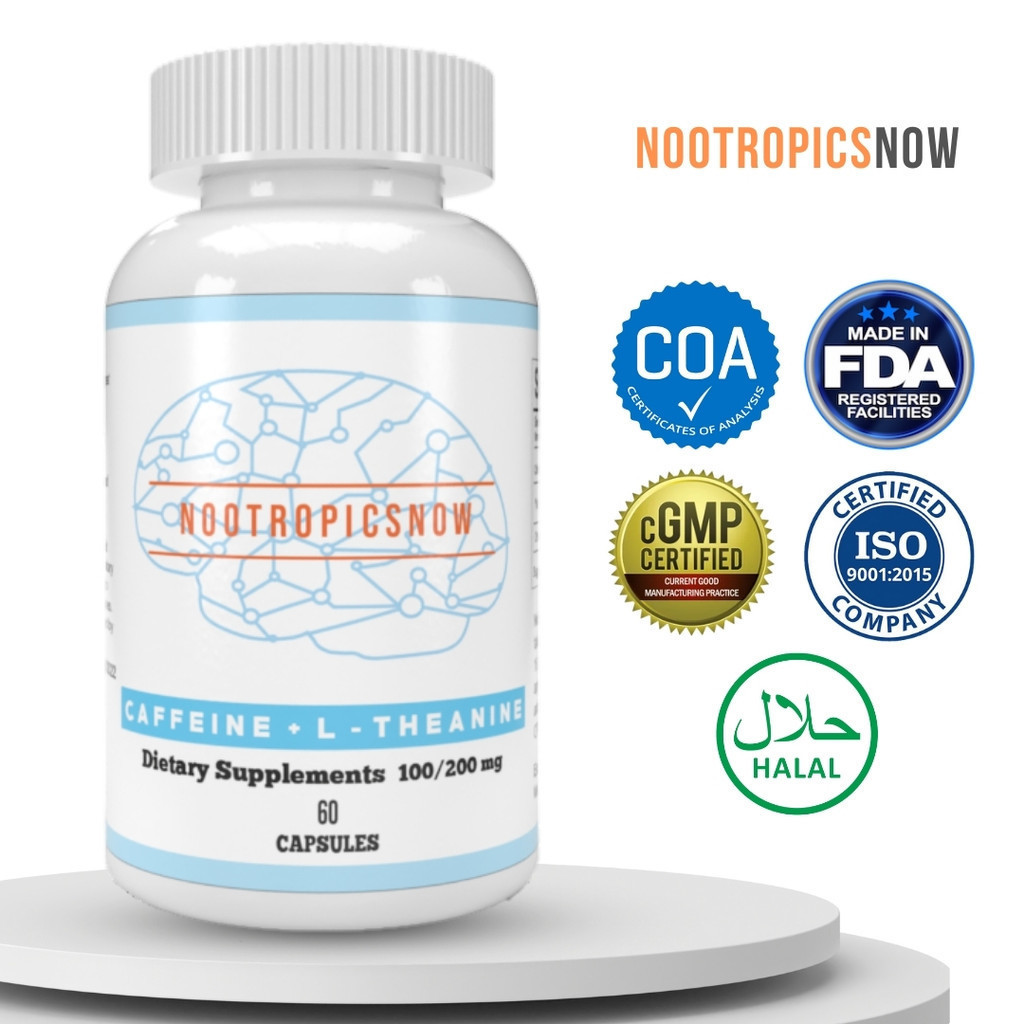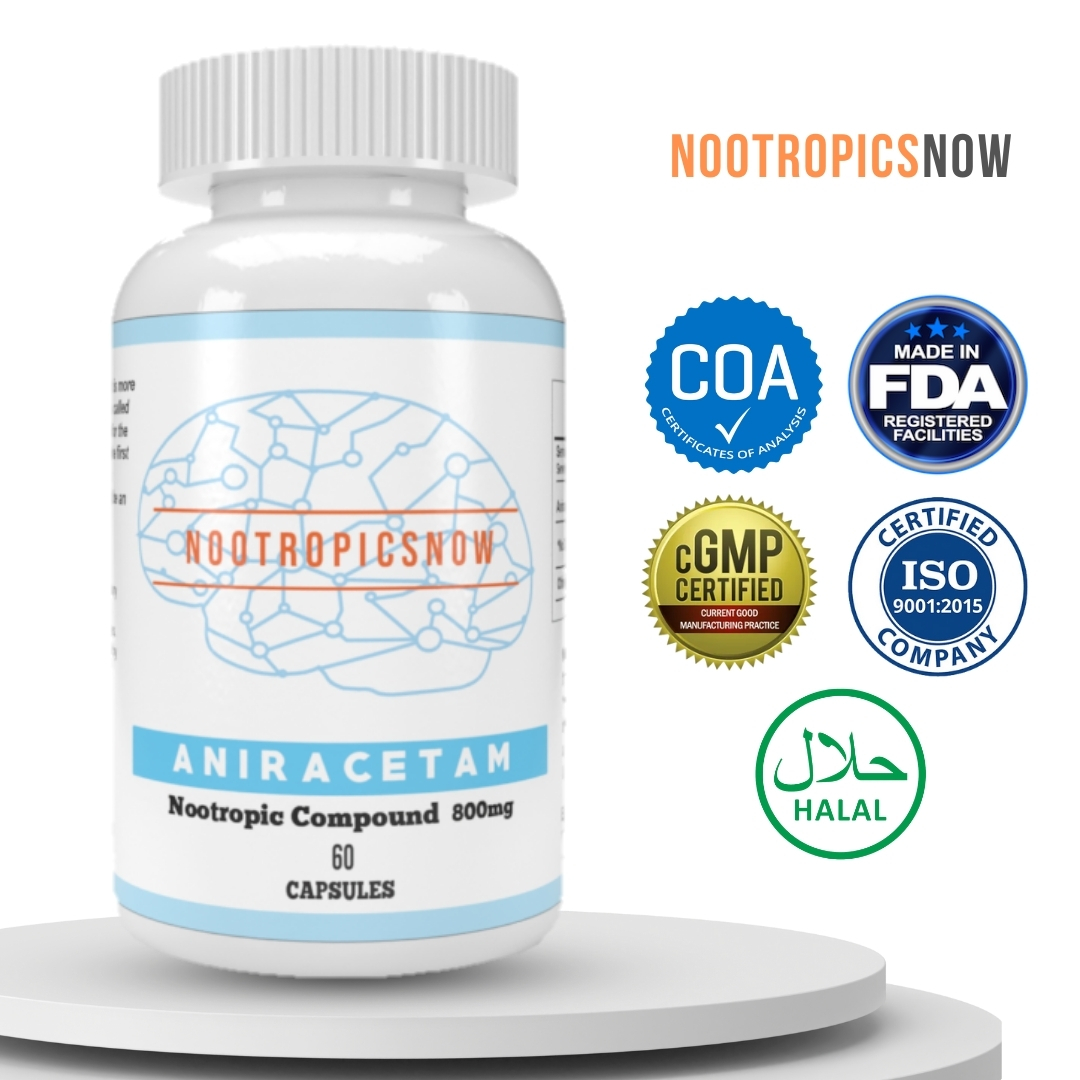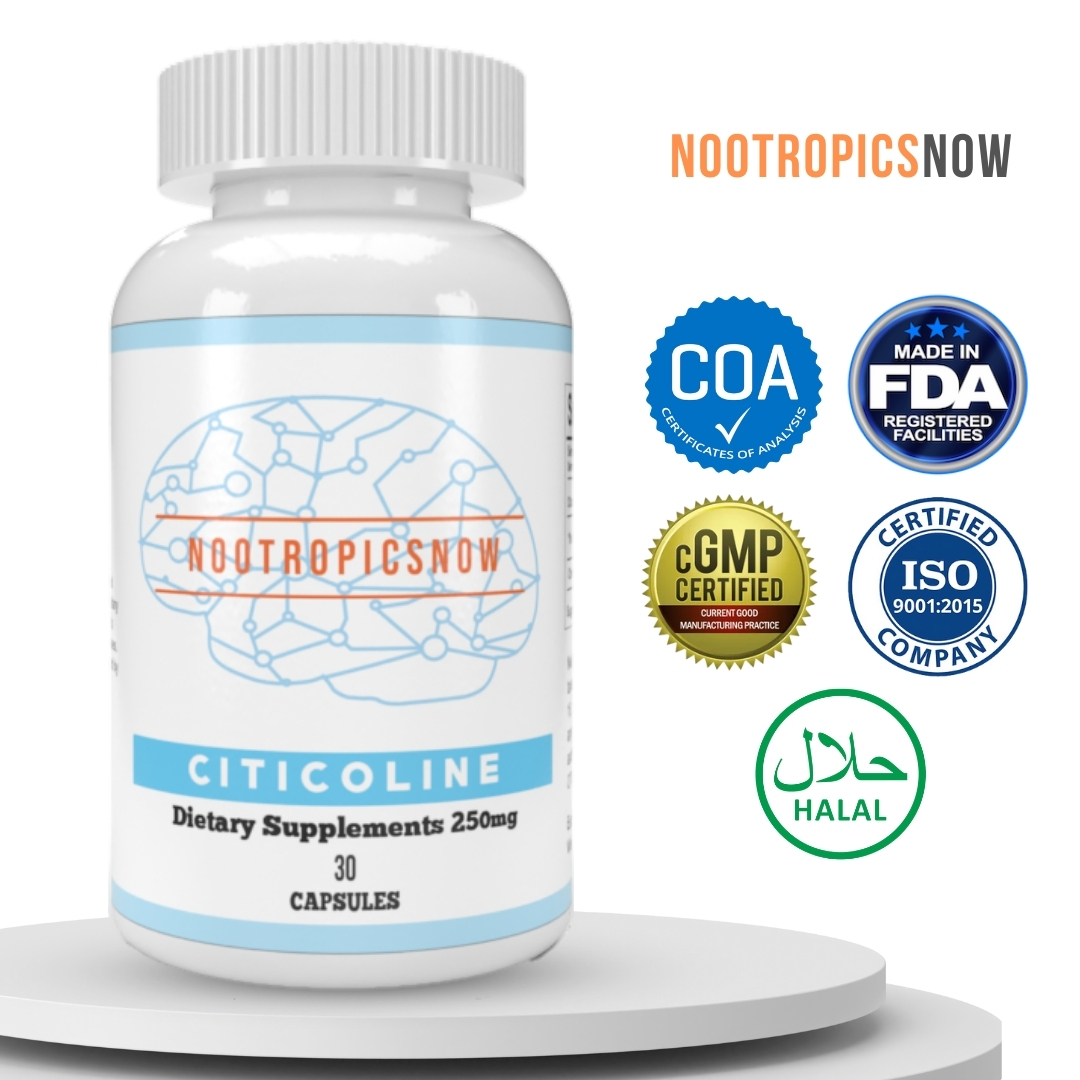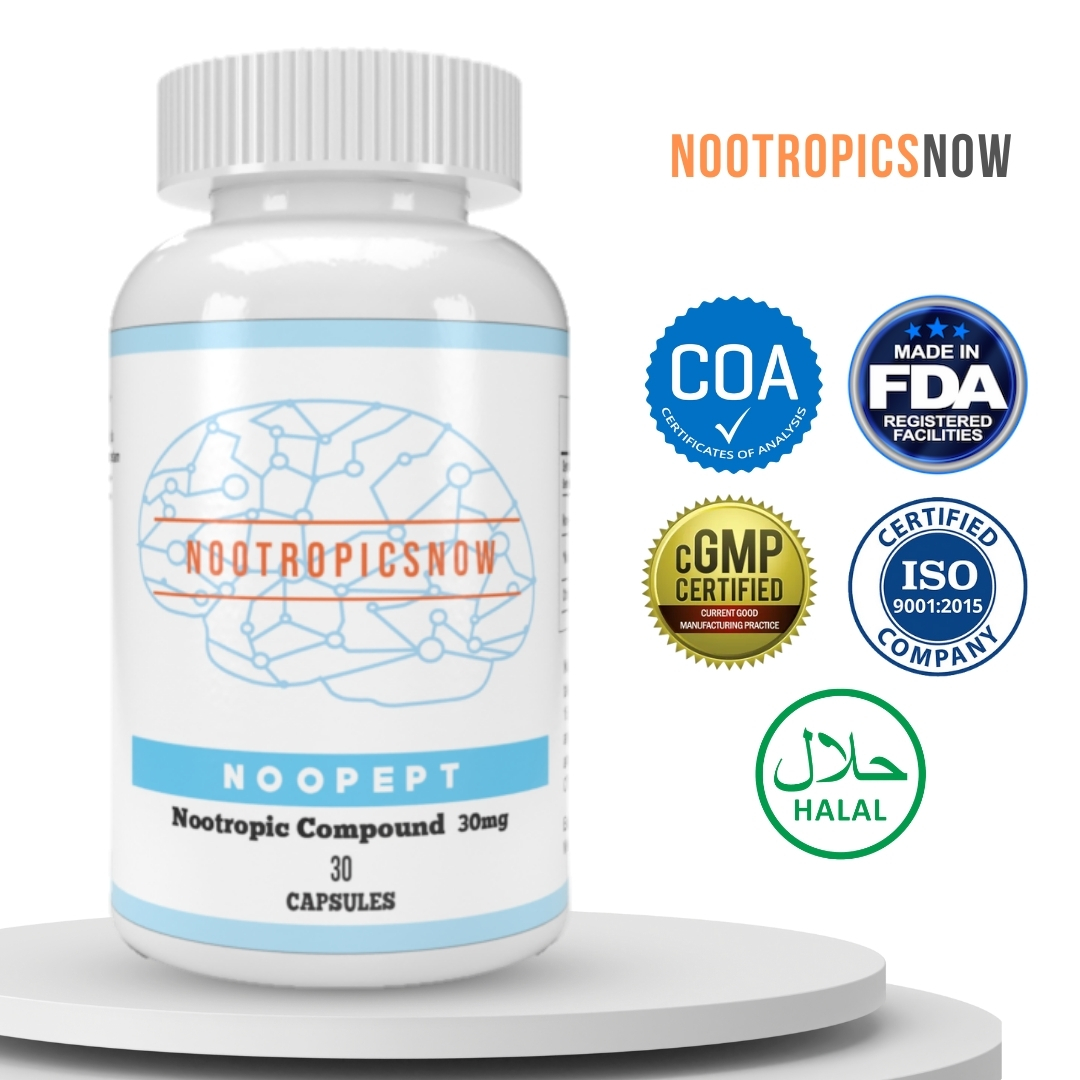Aniracetam Effects: Benefits & Side Effects

Aniracetam Effects: A Comprehensive Overview
Aniracetam, a synthetic nootropic of the racetam family, has garnered attention for its potential cognitive benefits. People use it hoping to improve memory, focus, and overall mental function. However, understanding aniracetam’s effects, both positive and negative, is crucial before considering its use. Therefore, this article will delve into the detailed science of aniracetam and its effects.
Aniracetam: What Is It?
Aniracetam is an ampakine nootropic, meaning it primarily influences the AMPA receptors in the brain. AMPA receptors play a critical role in synaptic plasticity, learning, and memory. Also, aniracetam differs from other racetams due to its fat solubility. Consequently, this impacts how it is absorbed and metabolized by the body.
Chemical Structure and Properties
Chemically, aniracetam is 1-p-anisoyl-2-pyrrolidinone. Because it is fat-soluble, it requires dietary fats for optimal absorption. Therefore, this means taking it with food can significantly improve its bioavailability and effects. Furthermore, aniracetam is metabolized by the liver into several active metabolites. These metabolites might also contribute to its overall effects.
Historical Context and Development

Aniracetam was first synthesized in the 1970s by Hoffmann-La Roche. It was initially developed for treating cognitive impairments. Since then, people have used it to enhance cognitive function in healthy individuals. While it is not approved by the FDA for any specific medical condition in the United States, it is available in some countries as a prescription drug.
Mechanisms of Action
Aniracetam exerts its effects through several mechanisms within the brain. These actions influence neurotransmitter systems. They also impact neuronal activity. Therefore, it is important to look at these mechanisms.
Influence on Neurotransmitters
Aniracetam primarily affects the cholinergic and glutamatergic systems. However, to a lesser extent, it also influences dopamine and serotonin. These neurotransmitter systems are vital for cognitive function, mood regulation, and overall brain health.
Acetylcholine: Aniracetam enhances the release and utilization of acetylcholine, a neurotransmitter critical for memory, learning, and attention. It does this by modulating acetylcholine receptors[1][3].
Glutamate: Aniracetam modulates AMPA receptors, which are a type of glutamate receptor. Glutamate is the primary excitatory neurotransmitter in the brain. This modulation enhances synaptic plasticity and long-term potentiation (LTP), processes essential for learning and memory[1][4].
Dopamine and Serotonin: Aniracetam influences dopamine and serotonin receptors, though to a lesser degree than acetylcholine and glutamate. This can result in mood elevation, reduced anxiety, and improved sociability.
Modulation of AMPA Receptors
AMPA receptors are crucial for fast excitatory synaptic transmission in the brain. Aniracetam acts as a positive allosteric modulator of AMPA receptors. This means it enhances their response to glutamate. So, by doing this, aniracetam improves synaptic strength and neuronal communication. This is vital for learning and memory consolidation. Specifically, aniracetam reduces the desensitization of AMPA receptors, allowing them to remain active for longer periods. Consequently, this prolongs the excitatory signal and improves cognitive function[1][4].
Impact on Brain Plasticity
Brain plasticity refers to the brain’s ability to reorganize itself by forming new neural connections throughout life. Aniracetam promotes brain plasticity. Thus, it enables the brain to adapt to new experiences and learn new information more efficiently. This neuroplasticity is facilitated by aniracetam’s effects on AMPA receptors. Additionally, acetylcholine release, which together enhance synaptic strength and neuronal communication.
Cognitive Benefits of Aniracetam
Aniracetam is used for its cognitive-enhancing properties. These potential benefits span improvements in memory, focus, learning, and sensory perception.
Memory Enhancement
One of the primary reasons people use aniracetam is to improve memory. Clinical studies and anecdotal reports suggest that aniracetam can enhance both short-term and long-term memory. Because aniracetam increases acetylcholine levels in the brain by 200-300%, it can improve memory and recall [1].
Short-Term Memory: Aniracetam may improve the ability to hold and manipulate information in mind. This can be beneficial for tasks such as problem-solving and decision-making.
Long-Term Memory: Aniracetam may enhance the consolidation of new memories. This can lead to better recall of information learned in the past.
Focus and Concentration
Aniracetam can improve focus and concentration. This makes it easier to stay on task and resist distractions.
Increased Attention Span: By modulating neurotransmitter activity, aniracetam helps increase attention span. This is essential for maintaining focus over extended periods.
Improved Task Performance: Because it enhances focus, aniracetam can improve performance on tasks requiring sustained attention and concentration.
Enhanced Learning
Aniracetam’s impact on brain plasticity and neurotransmitter systems can facilitate learning. This can be particularly useful for students and professionals who need to acquire new knowledge and skills. Aniracetam improves memory, and it can be used as a study aid [1].
Faster Acquisition of Information: By enhancing synaptic plasticity, aniracetam can speed up the process of learning new information.
Improved Comprehension: Aniracetam may enhance comprehension and understanding, making it easier to grasp complex concepts.
Sensory Perception
Some users report that aniracetam enhances sensory perception. They experience increased clarity and intensity of visual and auditory stimuli.
Visual Acuity: Colors may appear brighter, and details may seem sharper. This makes surroundings appear more vibrant [1].
Auditory Perception: Sensitivity to sounds may increase, allowing users to notice subtle nuances in music and other auditory experiences [1].
Clinical Research and Evidence
While anecdotal reports tout aniracetam’s cognitive benefits, it’s important to examine the scientific evidence. Clinical studies have explored aniracetam’s effects on cognitive function in various populations.
Studies on Cognitive Impairment
Several studies have investigated aniracetam’s effects on individuals with cognitive impairment, such as those with Alzheimer’s disease or age-related cognitive decline.
A study involving 276 patients with cognitive disorders showed that aniracetam improved emotional states and motor functionality within three months. Cognitive performance was boosted within six months [1].
Research has indicated that aniracetam can improve cognitive function and daily living activities in elderly patients with mild to moderate dementia.
Some studies suggest that aniracetam may have a neuroprotective effect, potentially slowing the progression of cognitive decline in certain conditions.
Studies on Healthy Individuals
The research on aniracetam’s effects in healthy individuals is more limited. Still, some studies suggest potential cognitive benefits.
Some studies have shown that aniracetam can improve memory and attention in healthy adults. However, the magnitude of these effects is often modest.
Research suggests that aniracetam may enhance cognitive performance under conditions of stress or fatigue.
It is important to note that the effects of aniracetam can vary widely among individuals. This is due to differences in genetics, lifestyle, and baseline cognitive function.
Dosage and Administration
Proper dosage and administration are essential for maximizing aniracetam’s benefits while minimizing the risk of side effects.
Recommended Dosage Guidelines
The typical dosage of aniracetam ranges from 750 mg to 1500 mg per day, divided into two or three doses.
Starting Dose: It is advisable to start with a lower dose (e.g., 750 mg per day) to assess tolerance and response.
Titration: The dosage can be gradually increased over several days or weeks, as needed.
Maximum Dose: Exceeding the recommended maximum dose (1500 mg per day) may increase the risk of side effects.
Timing and Frequency
The timing and frequency of aniracetam administration can affect its effects.
With Food: Aniracetam is fat-soluble. Therefore, it should be taken with food containing dietary fats to enhance absorption.
Divided Doses: Dividing the daily dose into two or three administrations can help maintain stable blood levels and prolong its effects.
Avoid Late Evening: Taking aniracetam late in the evening may interfere with sleep due to its stimulating effects.
Administration Methods
Aniracetam is typically available in capsule, tablet, or powder form.
Capsules and Tablets: These are convenient for precise dosing and ease of administration.
Powder: Powdered aniracetam can be mixed with water or other beverages. Therefore, it can allow for flexible dosing. However, it may have a bitter taste.
Potential Side Effects
Like all drugs and supplements, aniracetam can cause side effects in some individuals. Understanding these potential side effects is crucial for safe use.
Common Side Effects
The most common side effects of aniracetam are generally mild and transient.
Headaches: Headaches are a common side effect, particularly at higher doses. This can often be alleviated by taking choline supplements.
Nausea: Some users may experience mild nausea, which can be reduced by taking aniracetam with food.
Gastrointestinal Discomfort: Other gastrointestinal symptoms, such as stomach upset or diarrhea, can occur but are usually mild.
Anxiety and Agitation: Aniracetam can cause anxiety or agitation, especially in individuals prone to these symptoms.
Rare Side Effects
Rare side effects are less common but can be more serious.
Insomnia: Aniracetam can interfere with sleep in some individuals. This is particularly true if taken late in the day.
Vertigo: Some users may experience dizziness or vertigo, especially at higher doses [4].
Skin Rash: Allergic reactions, such as skin rash or itching, are possible but uncommon [4].
Managing Side Effects
Several strategies can help manage or reduce aniracetam side effects.
Dosage Adjustment: Reducing the dosage can often alleviate mild side effects.
Choline Supplementation: Choline supplements can help prevent or reduce headaches associated with aniracetam use [1][3].
Timing of Administration: Taking aniracetam earlier in the day and with food can help minimize sleep disturbances and gastrointestinal discomfort.
Interactions and Precautions
Aniracetam can interact with other medications or supplements. Therefore, taking certain precautions is important.
Drug Interactions
Aniracetam may interact with certain medications.
Anticoagulants: Aniracetam may have mild antiplatelet effects. Thus, it could increase the risk of bleeding when taken with anticoagulants.
Cholinergic Drugs: Aniracetam can enhance the effects of other cholinergic drugs. This could lead to excessive cholinergic activity and side effects.
CYP450 Substrates: Aniracetam is metabolized by CYP450 enzymes in the liver [3]. Consequently, it could potentially interact with other drugs that affect these enzymes.
Contraindications
Certain conditions may make aniracetam use inappropriate or unsafe.
Pregnancy and Breastfeeding: The safety of aniracetam during pregnancy and breastfeeding is unknown. Therefore, it should be avoided in these situations.
Liver or Kidney Disease: Individuals with liver or kidney disease may need to use aniracetam with caution, as it is metabolized by the liver and excreted by the kidneys.
Bleeding Disorders: Due to its potential antiplatelet effects, aniracetam should be used cautiously in individuals with bleeding disorders.
Precautions
Before using aniracetam, consider the following precautions.
Consult a Healthcare Provider: Before starting aniracetam, especially if you have underlying health conditions or are taking other medications, consult with a healthcare provider.
Start with a Low Dose: Begin with a low dose and gradually increase it as needed to assess tolerance and response.
Monitor for Side Effects: Pay attention to any side effects and discontinue use if they become bothersome or severe.
Purchase from Reputable Sources: Ensure that you are purchasing aniracetam from a reputable source to ensure quality and purity.
User Experiences and Reviews
Real-world experiences can provide valuable insights into aniracetam’s effects.
Anecdotal Reports
Many users report positive experiences with aniracetam, including improved memory, focus, and mood. Some users also report enhanced sensory perception and creativity. However, the effects of aniracetam can vary significantly among individuals. Not everyone experiences the same benefits.
Online Forums and Communities
Online forums and communities dedicated to nootropics can be a valuable source of information and support. Users often share their experiences, dosages, and stacking strategies. It is important to approach this information critically. Always consider that individual responses can vary widely.
Expert Opinions
Expert opinions from healthcare providers and researchers can provide a balanced perspective on aniracetam’s benefits and risks. These experts can offer guidance on appropriate use and potential interactions.
Legal and Regulatory Status
The legal and regulatory status of aniracetam varies by country.
United States
In the United States, aniracetam is not approved by the FDA for any specific medical condition. It is legally available as a dietary supplement. However, this means that its manufacture and sale are not subject to the same regulations as prescription drugs.
Other Countries
In some countries, such as certain European nations, aniracetam is available as a prescription drug for treating cognitive impairments. The regulatory status of aniracetam can change over time. Therefore, it is important to check the current laws in your region.
Alternatives to Aniracetam
If aniracetam is not suitable or available, several alternative nootropics may provide similar cognitive benefits.
Other Racetams
Other racetams, such as piracetam, oxiracetam, and pramiracetam, may offer similar cognitive-enhancing effects. Each racetam has a slightly different mechanism of action and may produce different effects in different individuals.
Natural Nootropics
Several natural nootropics have shown promise for enhancing cognitive function. These include:
Bacopa Monnieri: An herb used in traditional medicine, Bacopa Monnieri, may improve memory and cognitive performance.

View Product
Lion’s Mane Mushroom: This mushroom has been shown to promote nerve growth and improve cognitive function.

View Product
Ginkgo Biloba: This herbal supplement may improve memory and blood flow to the brain.

View Product
Caffeine and L-Theanine: This combination can enhance focus and alertness without the jitters associated with caffeine alone.

View Product
Lifestyle Factors
Lifestyle factors can also play a significant role in cognitive function.
Diet: A healthy diet rich in fruits, vegetables, and omega-3 fatty acids can support brain health.
Exercise: Regular physical activity improves blood flow to the brain and enhances cognitive function.
Sleep: Getting adequate sleep is essential for memory consolidation and overall cognitive performance.
Mental Stimulation: Engaging in mentally stimulating activities, such as reading, puzzles, and learning new skills, can help maintain cognitive function.
Future Research Directions
Future research can help to better understand aniracetam’s effects. This will help with the long-term safety, and potential clinical applications.
Clinical Trials
Further clinical trials are needed to evaluate aniracetam’s efficacy and safety in different populations, including those with cognitive impairment and healthy individuals. These trials should use standardized outcome measures and rigorous methodologies.
Mechanisms of Action
Additional research is needed to fully elucidate the mechanisms of action of aniracetam, including its effects on neurotransmitter systems, brain plasticity, and cellular signaling pathways.
Long-Term Effects
Long-term studies are needed to assess the long-term effects of aniracetam use on cognitive function and brain health. These studies should also investigate potential risks and benefits associated with prolonged use.
Conclusion
Aniracetam is a nootropic compound that can improve cognitive functions. These include memory, focus, and learning. Because of its actions on the cholinergic and glutamatergic systems, it can enhance these areas. However, potential side effects and drug interactions need careful thought before use.
Th
Aniracetam Effects: A Comprehensive Deep Dive
Aniracetam, a popular nootropic belonging to the racetam family, has garnered attention for its potential to enhance cognitive function and improve overall brain health. This comprehensive section provides an in-depth exploration of aniracetam’s mechanisms of action, its cognitive benefits, potential side effects, dosage guidelines, and user experiences.
Understanding Aniracetam’s Mechanisms of Action
Aniracetam’s cognitive-enhancing effects stem from its multifaceted influence on several key neurotransmitter systems within the brain. It does not directly bind to receptors like many pharmaceuticals, but it rather modulates the activity of these receptors. This intricate action leads to a cascade of beneficial neurological effects.
Impact on the Cholinergic System: Aniracetam significantly boosts acetylcholine (ACh) activity, a crucial neurotransmitter for memory, learning, and overall cognitive processing. Specifically, aniracetam enhances the release of ACh and also upregulates the sensitivity of ACh receptors. This dual action ensures that ACh, once released, exerts a more potent effect on neurons. Furthermore, it increases the synthesis of acetylcholine. Subsequently, this activity leads to improved memory consolidation and recall capabilities. People report better focus and an enhanced ability to retain new information.

View Product
Modulation of the Glutamatergic System: Aniracetam also interacts with the glutamatergic system, particularly by modulating AMPA (α-amino-3-hydroxy-5-methyl-4-isoxazolepropionic acid) receptors. AMPA receptors are ionotropic glutamate receptors that play a vital role in synaptic plasticity, a process fundamental to learning and memory. Aniracetam prevents the desensitization of AMPA receptors, leading to prolonged and enhanced glutamatergic neurotransmission. This modulation results in improved cognitive flexibility, better decision-making, and enhanced ability to process complex information.
Influence on Dopamine and Serotonin Systems: Beyond the cholinergic and glutamatergic systems, aniracetam also demonstrates an affinity for dopamine and serotonin receptors. While its interaction isn’t as pronounced as with ACh and glutamate, it contributes to mood regulation and emotional well-being. Some research suggests that aniracetam can act as a mild anxiolytic (anxiety-reducing) agent, potentially by modulating serotonin levels. Consequently, this contributes to a more balanced and positive mental state, which indirectly benefits cognitive performance.

View Product
Cognitive Benefits of Aniracetam: A Closer Look
The mechanisms of action detailed above translate into a range of cognitive benefits that make aniracetam a popular choice among nootropic users.
Enhanced Memory and Recall: Aniracetam’s primary benefit is its ability to improve both short-term and long-term memory. Users often report an enhanced ability to recall information learned in the past, as well as improved encoding of new memories. This effect is particularly beneficial for students, professionals, and anyone seeking to boost their memory capacity.
Improved Learning Ability: By modulating both acetylcholine and glutamate, aniracetam facilitates synaptic plasticity, the basis of learning. People report being able to grasp new concepts more quickly and retain information more effectively when using aniracetam. This is especially helpful for acquiring new skills or mastering complex subjects.

View Product
Heightened Focus and Concentration: Aniracetam promotes improved focus and concentration by modulating neurotransmitter activity in the prefrontal cortex, the brain region responsible for attention and executive functions. Users report experiencing a greater ability to sustain attention and filter out distractions, leading to increased productivity and mental clarity.
Enhanced Sensory Perception: Many users report an increased vividness in their sensory experiences, particularly in visual and auditory perception. Colors may appear more vibrant, and sounds may seem richer and more detailed. While the exact mechanism behind this effect is not fully understood, it’s believed to be related to aniracetam’s modulation of neurotransmitter activity in sensory processing areas of the brain.
Mood Elevation and Reduced Anxiety: Aniracetam has shown some anxiolytic (anxiety-reducing) effects in studies, likely due to its interaction with serotonin receptors. This can lead to a more positive and balanced mood, which can indirectly enhance cognitive performance by reducing stress and promoting a more relaxed mental state.
Dosage Guidelines for Aniracetam
Determining the appropriate dosage of aniracetam is critical to maximizing its cognitive benefits while minimizing the risk of side effects. Dosage can vary widely based on individual factors like body weight, sensitivity to the substance, and desired effects.

View Product
Typical Dosage Range: The most commonly recommended dosage range for aniracetam is between 750mg to 1500mg per day. This dose is often divided into multiple administrations throughout the day, for example, 400-750mg twice daily.
Starting Dose: For those new to aniracetam, it’s best to start with a lower dose, such as 400mg twice a day, to assess individual tolerance and sensitivity. This allows you to gauge how the substance affects you and reduce the risk of adverse reactions.
Administration: Aniracetam is fat-soluble, which means it’s best absorbed when taken with a source of dietary fat, such as coconut oil, olive oil, or a meal containing healthy fats. This enhances bioavailability and ensures that the substance is effectively absorbed into the bloodstream.
Cycling: While there is no definitive evidence to suggest that cycling aniracetam is necessary, some users prefer to cycle its use to prevent tolerance from developing. A common cycling strategy involves taking aniracetam for a period of weeks or months, followed by a break of equal duration.
Individual Variation: Dosage adjustments should be based on individual response and tolerance. Some people may find that lower doses are effective for them, while others may require higher doses to achieve the desired effects. Always prioritize careful monitoring of your body’s response and adjust the dosage accordingly.
Potential Side Effects and Precautions
While aniracetam is generally considered safe and well-tolerated, it can cause side effects in some individuals. Being aware of these potential side effects and taking appropriate precautions is crucial for responsible use.
Common Side Effects: The most commonly reported side effects of aniracetam include headaches, nausea, anxiety, and gastrointestinal discomfort. These side effects are typically mild and transient, often resolving on their own or with dosage adjustments.
Headaches: Headaches are a relatively common side effect, particularly when starting aniracetam. This can be due to the increased demand for choline in the brain as aniracetam enhances acetylcholine activity. Supplementing with a choline source, such as Alpha-GPC or CDP-choline, can often alleviate these headaches.

View Product
Nausea: Some users may experience nausea, especially when taking aniracetam on an empty stomach. Taking it with food or a source of fat can help to reduce nausea.
Anxiety: While aniracetam can have anxiolytic effects for some, others may experience increased anxiety or restlessness. This is more likely to occur at higher doses. If anxiety becomes problematic, consider reducing the dosage or discontinuing use.
Interactions: Aniracetam can interact with other medications and supplements, particularly those that affect neurotransmitter activity or liver function. It is essential to consult with a healthcare professional before taking aniracetam, especially if you are taking any other medications.
Contraindications: Aniracetam is not recommended for pregnant or breastfeeding women, as its effects on fetal development or infant health are not well-established. It should also be avoided by individuals with severe liver or kidney disease, as these conditions can affect the metabolism and excretion of the substance.
Long-Term Safety: While short-term studies have generally shown aniracetam to be safe, the long-term effects of its use are not fully understood. More research is needed to assess the potential risks and benefits of long-term aniracetam use.
User Experiences and Anecdotal Reports
Anecdotal reports and user experiences provide valuable insights into the subjective effects of aniracetam. While these reports are not a substitute for scientific evidence, they can offer a more nuanced understanding of how aniracetam affects different individuals.
Positive Experiences: Many users report experiencing significant cognitive enhancements with aniracetam, including improved memory, increased focus, enhanced learning ability, and heightened sensory perception. Some also report mood elevation and reduced anxiety.
Variability in Response: User experiences with aniracetam can vary significantly. Some individuals may experience profound cognitive benefits, while others may notice little or no effect. This variability highlights the importance of individual experimentation and careful monitoring of one’s own response.
Importance of Dosage and Stacking: User reports suggest that finding the optimal dosage and combining aniracetam with other nootropics (stacking) can significantly impact its effectiveness. Some users report enhanced effects when combining aniracetam with choline sources, while others find that it synergizes well with other racetams or natural nootropics.

View Product
Placebo Effect: It’s important to acknowledge the potential role of the placebo effect in user reports. The expectation of cognitive enhancement can sometimes lead to subjective improvements, even if the substance itself has no inherent effect.
Aniracetam: A Powerful Nootropic Tool
Aniracetam is a potent nootropic that offers a range of cognitive benefits, including improved memory, enhanced focus, and increased learning ability. However, responsible use requires careful consideration of dosage, potential side effects, and individual factors. By conducting thorough research, consulting with a healthcare professional, and monitoring your own response, you can harness the cognitive-enhancing potential of aniracetam while minimizing the risk of adverse effects. While anecdotal evidence is overwhelmingly positive, remember that each individual reacts uniquely. Approaching aniracetam with an open mind, but with respect for its potential effects, will allow you to achieve the desired results in a responsible, measured way.












